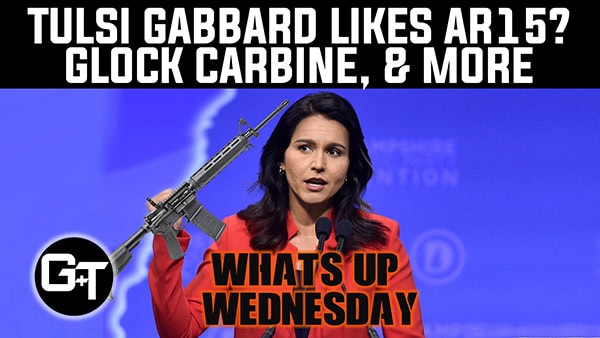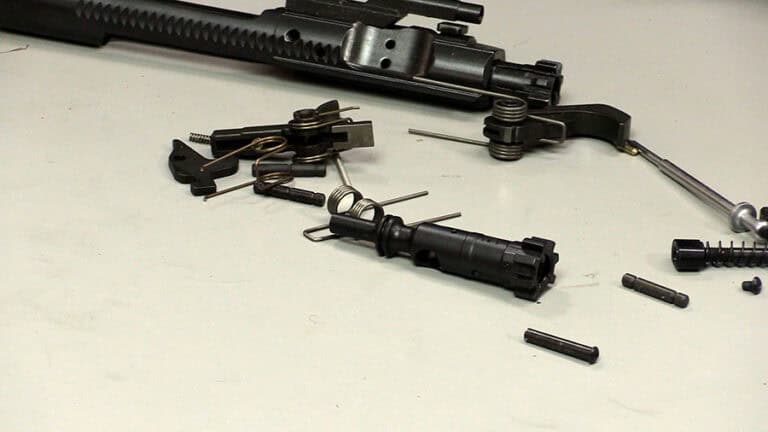TAG Precision—American-made RMR Plate for Kimber
For users of optics-ready Kimber 1911 and 2K11 pistols, TAG Precision has announced…
For users of optics-ready Kimber 1911 and 2K11 pistols, TAG Precision has announced…
Fountain Valley, CA—SureFire, LLC, manufacturer of the world’s finest—and most innovative—illumination tools and…
Shinenyx—creators of a cutting-edge fusion of digital night vision and thermal imaging technology—has…
All shooting is a balance between speed and precision. By that I mean you can…
The Mod-Navy Qual I’ve been doing this qual (or drill, or whatever the current nom…
• Built for road trips and off-road use• Manual transmission equipped• Wrapped in MultiCam Arctic…
Shooting feral hogs from a helicopter in Texas…
Back in December 2016, I was in Texas to attend Will Petty’s last VCQB class of 2016. While there, I met a great guy named Chris Reeves, of Triarc Systems. Chris and I worked together for the duration of the class, and he mentioned that if I were ever to return to TX, I should look him up and meet his friends from Last Shadow. Triarc Systems works with Last Shadow and assists them with custom made, and finely tuned firearms.
I was unfamiliar with Last Shadow and the services they provide, so I had to do a little reading about who they were, and the service they provided. I was pretty impressed.
A little history. Texas, like many other states, has a strong conservation history regarding land management and naturally-occurring, or foreign-introduced invasive species. According to www.texasinvasives.org and www.stateimpact.npr.org, the top five invasive species in Texas today are:
While fact-checking for this article, I came across a February 2017 Fox News article that currently estimates the feral hog population of Texas to be approximately 2.5 million, which accentuates the drastic and exponential growth of feral hog population in contrast to the aforementioned estimated population of 1.5 million I took from www.texasinvasives.org, which cited data from 2011. Obviously, the feral hog infestation is a big issue for farmers and the agricultural industry in Texas.
In 2011, Texas lawmakers, in an attempt to address the concern of the feral hog population, allowed the utilization of aerial eradication methods to deal with the burgeoning feral hog population. Last Shadow was poised to step in and assist with eradication efforts, and created a unique business model that provided relief to local farmers, enhanced conservation efforts, and created a completely unique adventure and service opportunity to citizens.
I had the opportunity to talk with Richard Potts from Paradise Helicopters Texas, and Barrett Blume, CEO and on-the-ground mastermind behind Last Shadow. Richard and Barrett teamed up, and under the Last Shadow banner, have developed Last Shadow into the amazing company that it is today.
Richard took the lead and answered a few background questions for me.
Chris Tran (CT): Can you two please describe your professional backgrounds for our readers?
Richard Potts (RP): Aviation has been in my family since I was 4. My first logbook entry was in 1968, and I’ve never strayed from it. I joined the U.S. Air Force out of High School and was a helicopter mechanic there. After I was discharged I told a guy in California I’d fix his helicopter if he’d show me how to fly it, now 36 years later I’m still doing the same thing.
CT: How did Last Shadow come into existence, and how long have you been in operation?
RP: The rules for aerial eradication have only been in effect for about 5 yrs. We recognized the need in the local area and it has taken off like wildfire. The popularity is remarkable from the landowners, to the community who recognize the need to attempt to control this invasive species.
CT: What is the overall business philosophy for your company and what principles do you adhere to that you believe are important for your customers to understand?
RP: Safety first, always. The most important thing to understand is that this is NOT a sport. This is an eradication attempt to eliminate an invasive species that is out of control.
CT: In my limited research, it is my understanding that feral hogs are rated as the #2 invasive species in Texas. Can you explain the scope of the issue, impact on local businesses, and how your hunts provide a crucial service to local landowners?
RP: Feral hogs can cause a landowner with 10K acres $250,000 in damage to and crops and equipment annually. Now the population is spreading into water sheds and starting to affect our drinking water. It is out of control. The operation that we run takes the fight to the habitat the pigs live in. We are not an end all cure all, but we do make an impact and according to Texas A&M AG Research studies, are one of the top two methods of hog control in the state.
CT: If left unabated, what risk do feral hogs pose to local infrastructure and economies?
RP: There is no end to the population growth if left unattended. Hogs are in the city limits of a number of cities across the state. We may never catch [up to] the population but we are working hard to.
CT: Hunting was not part of my upbringing, and typically I don’t think that I would support such an endeavor without harvesting the kills. That being said, with the aforementioned benefits to feral hog hunting, I could justify the taking of life to serve a purpose. Are there any other considerations other than aforementioned societal benefits that feral hog eradication presents?
RP: If I could find a way to utilize the animals after they are dispatched, I would be delighted. To date however, I have had zero success in making that work. Getting to the animals after they are killed has proven impossible. During the day when we perform our operations, the hogs are in areas that are impossible to access without doing more damage to the land or watersheds. 15 minutes after they are killed, scavengers and predators are already at work to remove the carcasses, and 5 days later, there is no trace.
CT: What messages do you want your customers to take away from the hunting experience that you offer?
RP: The most important thing I want to convey to our customers is that we are doing a much needed service to the community. The landowners DO NOT pay for our service. The customers that we train onsite burden the cost of the operation. This allows us to be very effective in this symbiotic relationship between landowner, customer, and our helicopter operation.
CT: Are there any other businesses that offer the same aerial services that Last Shadow provides, and if so, what sets your team apart from the competition?
RP: As in any opportunity that presents itself, there are “flash in the pan” operations that have sprung up around the state that are here today and gone tomorrow. The thing that sets us apart are our people. We set out from the beginning to be safe, effective, and beneficial to the community and pride ourselves in that achievement. This operation is based on 50 years of “what knows” and the ACETA program started by the Department of the Interior to address aerial operations needed by the U.S. Forest Service. It stands for Aerial Capture Eradication and Tagging of Animals. Using these guidelines sets us apart from operations that simply hand you a weapon and point and shoot with no formal training programs. We are the leader in this industry.
CT: Is there anything else that you want readers to know about your business that I haven’t covered?
RP: Only to reiterate that this is an eradication attempt and NOT a sport hunt. We have a huge issue here in Texas, and all over the U.S. for that matter. Louisiana, Oklahoma and I believe New Mexico have adopted similar programs for their Feral Hog problem. It is an issue and we can use all the help we can get!
CT: If readers are interested in booking a hunt with Last Shadow, what is the best way to get in contact with you, and what considerations should prospective clients take into consideration before booking a hunt?
RP: We can be reached at our website: www.lastshadow.com. The most important thing I would like to tell prospective customers is that shooting from a helicopter is VERY addicting. The first one’s not quite free, but you will be back for more!
Participating in a Last Shadow eradication exercise was a once-in-a-lifetime experience. I had never been in a helicopter before, never shot from the air before, and never hunted before. I was quite excited to experience the event, and it was a trifecta of bucket list life events for me.
I was in Austin, TX for a work conference back in February, and after the conference concluded, Chris from Triarc Systems was kind enough to pick my buddy and me up from my hotel in downtown Austin and drive us to Temple, Texas, the home of Last Shadow. Once there, I met with Richard, Barrett, and Joe, one of their staff members.

Richard wasn’t kidding, they take safety very seriously and provided a succinct, professional, and thorough safety briefing. Joe served as our safety officer for the tour, and briefed us on mounting and dismounting the helicopter (a Bell MD500E, affectionately named “Clarice”), safety harnessing, and safe weapon manipulation in and around the helicopter.
After the safety briefing, my buddy and I filled out our waivers, confirmed that our hunting permits were in order and verified, and we literally took off.
Joe, our pleasant and ever-smiling safety officer strapped us in, briefed us on comm protocol, gave us a grab bag of loaded magazines, and my buddy and I each were handed a Triarc Systems tuned San Tan Tactical suppressed SBR. Fortuitous, as I am a strong supporter of San Tan Tactical, as I own several San Tan Tactical builds already. The suppressors keep the SBRs quieter than the noise of the helicopter rotors, a courtesy to the farmers whose property we flew over.
Once airborne, we began to fly over approved farmers’ land. Richard talked to us throughout the flight, and called out hog tracks and rooting/foraging evidence for us. It was still early in the morning and pretty chilly, and we did not encounter packs of feral hogs roaming around. After a short period of time my buddy spotted and called out a single female sow within a copse of trees near a riverbed. Richard deftly maneuvered the helicopter and flew alongside the sows’ running trajectory allowing my partner to start lining up his shots.
A note. Shooting feral pigs from the air is not a precision sniper game. Both my partner and I learned this very quickly. Feral hogs have a tough hide and several inches of hide, fat, and gristle to punch through in order to get to the vital organs within. We were shooting M855 ammo, and despite its penetration capabilities, we were instructed to shoot “P for Plenty,” as Chris from Triarc Systems advised. It was necessary to send multiple rounds down range with a quickness in order to get rounds on and make an effective, quick kill. No one shot stops with 5.56 for these hogs.
Being a total initiate, I was surprised that we could put 5-10 shots on a single hog from the air before it went down. These things are tough. My buddy (also a LEO) and I thought, despite the advice from Chris, that a well-placed shot would take care of business. Nope. Chris was right, “P for Plenty.” Walk the shots in, get multiple rounds on target, and move on to the next.
We searched several properties, downed a hog or two, and then landed at another local air field to refuel after about an hour. Once airborne again, we landed a coyote or two, and another hog. Not the most bountiful of eradication efforts, but that’s the way it went, 3 hogs and 3 coyotes between the two of us over the course of two hours airborne. I wish we could have taken more down, but like fishing, sometimes they’re there, sometimes, they’re not. I wasn’t disappointed in the slightest; the experience was amazing, and frankly, I can see a bit more of my disposable income going back to Last Shadow the next time I get back to Texas. Richard was right, I definitely have a thirst for more.
All in all, my experience with Last Shadow was truly a once-in-a-lifetime experience, and a privilege. The fact that we had an opportunity to affect Texas farmers in a positive way made the experience even more meaningful. It should be noted that this service is provided to the farmers for free, their only obligation is to permit Last Shadow to fly over and shoot on their land. Some farmers take advantage of that opportunity, some don’t, but the net result is a positive impact for the greater good of ALL landowners in the area, and those that book tours with Last Shadow should know, and take pride in the fact, that they are really helping local American farmers in a tangible way.
Want to know more about Last Shadow? Check them out on the web:
On Facebook:
https://www.facebook.com/LastShadowTX/
On Instagram:
https://www.instagram.com/lastshadowtx/
Also check out my buddy Chris at Triarc Systems on the web:
On Facebook:
https://www.facebook.com/triarcsystems/
On Instagram:
https://www.instagram.com/triarcsystems/
* The views and opinions expressed on this web site are solely those of the original authors and contributors. These views and opinions do not necessarily represent those of Guns & Tactics Magazine,
the administrative staff, and/or any/all contributors to this site.
Chris Tran is a police officer for a large municipality in the Pacific Northwest. He writes equipment reviews aimed towards the everyday user with a focus on functionality, durability, and cost effectiveness.

In this episode of What’s Up Wednesday, Tulsi Gabbard is no longer a democrat and she likes guns, GLOCK AR15 is real, more Sig news and more.

Dave talks about what spare parts you should consider having around for your AR15. Ranging from small parts to complete assemblies.
If your trusty GLOCK or SIG ever aspired to be something more, perhaps jealous of the 1970s-vintage Beretta Model 93R machine pistol, now there’s an option to put…

Own a CMMG BANSHEE or RESOLUTE? With your existing Sig Sauer M17/P320 and you have the convenience of magazine interchangeability.
There will never be a short supply of rifle/shotgun slings, but one company called, Tactical Universal Clip, has a completely different take on choosing the perfect sling for…
[dcs_img_center framed=”no” w=”600″ h=”409″] http://gunsandtactics.wpengine.com/wp-content/uploads/2012/12/Promoknife_600-409.jpg [/dcs_img_center] [dcs_post_top] [dcs_fancy_header color=”#000000″ fweight=”bold”]Buy one of these tough American made knives and we will contribute a portion to The Navy Seal Foundation…
© 2025 UN12 Magazine
© 2025 UN12 Magazine
Wait! Don’t forget to